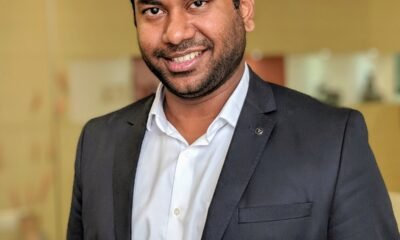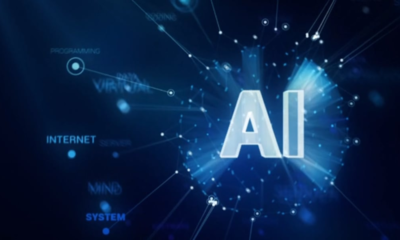Education
Seiji Isotani’s Mission to Humanize AI in Education
Newswise — As Penn GSE expands its leadership in AI and education, newly hired associate professor Seiji Isotani adds a vital perspective shaped by decades of work in Brazil, Japan, and the United States.
A pioneer in intelligent tutoring systems, Isotani develops AI tools that adapt to the needs of students and teachers—especially in under-resourced settings. But for him, technology is never the starting point.
In this Q&A, he reflects on the childhood experience that launched his career, the importance of human-centered design, and why responsible AI must begin with understanding the people it’s meant to serve.
Q: What originally drew you to the field of educational technology?
A: Working with educational technology holds special meaning for me, inspired by a personal experience. As a child, I struggled in school. I couldn’t read or work with numbers at age 7, and some even thought I had a learning disability. Fortunately, my mom, a talented public school math teacher, and my dad, a professor at the University of São Paulo, worked with me every night until I caught up. Eventually, we discovered that my difficulties were due to issues with vision, communication, and hearing.
Once those were addressed, everything changed. I went from falling behind to becoming one of the top students, especially in STEM subjects.
That transformation lit a fire in me. I wanted to help others experience that same change, and I started to help other students with their struggles during class. When I got my first computer at age 11, I was instantly in love. I taught myself to program and quickly realized that I could use this technology to help other students learn in ways that worked for them. That spark led me to educational technology, and it still fuels my work today, particularly in one of my main research areas: intelligent tutoring systems.
Q: Your work explores the use of AI to improve learning. What’s one way you think AI could genuinely help students or teachers?
A: One of the most exciting ways AI can make a difference is by acting as a true partner for teachers, helping them do what they already do well or even improve their practices, but with more insight and support. By deeply understanding teachers’ needs (as explored in my recent study) and developing AI-powered tools like those in the MathAIde project, we’ve shown that even in resource-constrained environments, teachers can receive timely, actionable feedback about their students’ learning. They can use AI to plan lessons more efficiently and get personalized suggestions for tailoring activities to each learner’s needs.
At the same time, students benefit from more engaging and personalized learning experiences, including gamified elements that adapt to their interests and help keep them motivated (as evidenced in another study of mine). It’s not about replacing teachers or increasing students’ cognitive offload. It’s about giving both teachers and students “superpowers” so they can shine and show all their might.
Q: What drew you to join the faculty at Penn GSE?
A: Honestly, I couldn’t imagine a better place to do the work I care about. Penn GSE is a powerhouse when it comes to rethinking education through innovation. I’ve admired the school’s deep commitment to investing in the field of AI in Education to create real-world impact, especially in K–12 education.
The opportunity to contribute to and grow with Penn GSE, by helping build a strong program that not only trains the next generation of AI in education leaders but also shapes the global conversation on how AI can support more accessible and meaningful learning experiences, is incredibly exciting to me!
Penn is already leading the AI in education agenda across top universities in the U.S. and around the world, and the chance to be part of that movement is truly inspiring. After meeting the faculty and students, it became crystal clear to me: this is where I want to be to help change the world. I’m especially excited to collaborate with such a passionate and visionary community made up of people who, like me, are committed to making education more human, more engaging, and more inspiring through the thoughtful and responsible development and use of AI.
Q: You’ve worked in both Brazil and the U.S.—how have those experiences shaped your perspective on education and innovation?
A: Working in Brazil and the U.S. has certainly shaped my perspective, and adding to my journey, I’ve also had the opportunity to collaborate closely with researchers and schools in other countries, such as Japan, where I completed my doctoral studies. These experiences across very different educational systems and cultures have given me the flexibility to embrace multicultural environments, understand diverse classroom contexts, and navigate the complexities of working in both low- and high-income communities.
What I’ve learned is that challenges in education are not exclusive to any one region. Whether I am working in a rural school in the Amazon, an urban district in the U.S., or a high-tech classroom in Japan, I encounter students and teachers who struggle, whether due to lack of infrastructure, insufficient support, or systems that do not fully meet their needs. These shared struggles, though expressed differently across contexts, have helped me become more connected to what really matters: understanding people and their goals. This is why a human-centered approach is at the heart of my work. For me, it’s not just about gathering data or training AI models. It’s about what we can do with AI and data to help people learn better, teach better, and feel more empowered. Designing AI in education means listening deeply to communities, co-creating solutions with them, and ensuring that the tools we develop truly serve the people they are meant to support.
Q: What’s something surprising or lesser known about your research that you enjoy sharing with others?
A: One thing that often surprises people is that I tend to avoid starting my projects by advocating for the use of AI. Even though I’m deeply involved in AI in education, I actually try to avoid introducing AI at the beginning, especially when the goal is to improve public policy through technology.
In fact, when people ask me, “How can we use AI to improve education policy?”, my first response is usually a question: “Do you already have a shared vision for the kind of education you want in your country or community? Do you have an understanding of the needs of your teachers, principals, students, and families?”
If we can’t answer those questions clearly, it’s very hard to use AI effectively, because we don’t yet know why we need AI or how it should be developed or used to actually serve the people it’s intended to help.
Thus, whether I’m working with a ministry of education or a local school, I begin by engaging deeply with people on the ground. And sometimes, AI is not the silver bullet; in fact, it often isn’t. What tends to work best is not AI alone, but a thoughtful combination of AI with practices rooted in the learning sciences and well-established educational strategies (e.g., structured pedagogy). Nothing flashy, just what works.
Q: When you’re not thinking about research, how do you like to spend your time?
A: Outside of work, my favorite role is being a dad. Spending time with my 4-year-old son and 8-year-old daughter brings me so much joy. They constantly remind me that the true wonders of the world live in small discoveries, in the curiosity to learn about everything, and in the joy of sharing what you’ve learned with those you love.
I have also practiced Judo for about 35 years. In my early days, I trained professionally for competitions and was fortunate to win state and national championships a few times. Although I had to stop training during the pandemic and haven’t returned to a dojo since, I hope to resume my practice in Philadelphia. In the meantime, I still enjoy “training” and playing Judo with my kids at home.
Finally, I also love trying new foods, exploring different cultures, and occasionally watching anime, a fun reminder of my “otaku” days back when I lived in Japan.
Q: Are you more hopeful or cautious about the role of AI in education over the next decade—and what gives you that outlook?
A: You tell me. Just kidding! I’m definitely more hopeful, but in a grounded and thoughtful way. AI is already shaping our society, and it holds incredible potential to transform education for the better, especially when it’s designed responsibly with people and for people. I’ve seen what happens when we get it right: teachers feel empowered, students feel seen and supported, and learning becomes more meaningful, engaging, and joyful.
I have a strong sense that once we move past this initial wave of hype and the overemphasis on the technology itself, we will enter a new phase. That is when the real breakthroughs in AI for education will emerge, focused on truly serving educational needs and empowering communities.
Education
Earl Richardson, who spotlighted HBCU funding disparities, dies : NPR

Earl Richardson was the president of Morgan State University between 1984 and 2010.
Morgan State University
hide caption
toggle caption
Morgan State University
Earl Richardson was a Black college president — “armed with history,” as a colleague described him — when he led a 15-year-long lawsuit that ended in a historic settlement for four Black schools in Maryland and put a spotlight on funding disparities for all of the nation’s historically Black colleges and universities (HBCUs).
Richardson’s death, at 81, was announced on Saturday by Morgan State University, located in Baltimore, where he served as president when he helped organize the lawsuit that began in 2006. It was settled in 2021 when the state of Maryland agreed to give $577 million in supplemental funding over 10 years to four HBCUs.
Richardson led Morgan State from 1984 to 2010 and he had long chafed at stretching the little funding he got from the state. In the lawsuit, plaintiffs argued that Maryland had historically underfunded its Black colleges and had put them at a disadvantage by starting and boosting similar programs at nearby majority-white schools.
David Burton, one of the plaintiffs, told NPR that the case was compared to Brown v. Board of Education, the landmark lawsuit that brought up similar issues of disparities in educational opportunities for Black students, but the Maryland case raised the issues for students in higher education.
In 1990, when Richardson was a new school president, students took over the administration building for six days to protest the school’s dilapidated classrooms and dorms, with roofs that leaked and science labs stocked with outdated equipment.
Edwin Johnson was one of those student protesters. “We originally were protesting against Morgan’s administration,” including Richardson, he said. “But then after we dig and do a little research, we find out it’s not our administration, but it’s the governor down in Annapolis that isn’t equipping the administration with what they need to appropriately run the school.”
The protest ended when the students marched 34 miles to Annapolis to demand a meeting with the governor.
Richardson, who spoke of taking part in civil rights demonstrations when he was in school, had subtly guided the students to the correct target, said Johnson, who is now the university’s historian and special assistant to the provost.
That protest helped pave the way to the future, historic lawsuit.
Because Richardson was the university’s president, and an employee of the state, he couldn’t sue the state. So, a coalition of students and former students was created, the Coalition for Equity and Excellence in Maryland Higher Education Inc., to serve as the plaintiff.
Still, Richardson was the visionary behind the lawsuit, said Burton, a Morgan State alumnus and now a strategic planner for businesses. “He was armed with history,” Burton said.
“Dr. Richardson knew where the skeletons were,” Burton added. He was “a force that the state could not reckon with because of his institutional knowledge.”
At one point, during the trial, state attorneys objected to Richardson’s presence in the courtroom and asked the judge to make him leave, even though he had a right to be there as an expert witness, said Jon Greenbaum, then the chief counsel of the Lawyer’s Committee for Civil Rights Under Law, who helped argue the lawsuit.
Richardson stayed in the courtroom and “because this was really a desegregation case,” said Greenbaum, he provided historical detail that became critical to the arguments made by the lawyers representing the plaintiffs.
The funding that resulted, and Richardson’s leadership, jump-started what is now called on campus “Morgan’s Renaissance.” Or sometimes, said Johnson: “Richardson’s Renaissance” — because during Richardson’s presidency, enrollment doubled, the campus expanded with new buildings and new schools were added, including a school of architecture and a school of social work.
Richardson’s work put a spotlight, too, on the funding disparities faced by HBCUs across the country. They are more likely than other schools to rely upon federal, state and local funding — money that has faced budget cuts in recent years. Compared to other universities and colleges, HBCUs get a higher percentage of their revenue from tuition and less from private gifts and grants, according to one study.
In testimony before the U.S. House of Representatives in 2008, Richardson emphasized the mission of HBCUs when he told lawmakers that Black schools like his educated the most talented Black students but also sought to attract students who didn’t consider, or thought they couldn’t afford, to go to college. “We can make them the scientists and the engineers and the teachers and the professors — all of those things,” he said. But only if “we can have our institutions develop to a level of comparability and parity so that we are as competitive as other institutions.”
Education
How millions of dollars in funding cuts will impact Hispanic Serving Institutions
Chancellor Sonya Christian of the California Community College system talks about the impact of funding cuts for students.
Education
Pvt schools bring in AI tools for better evaluation of students | Chennai News

Chennai: When Akansha (name changed) fumbled over a poorly worded maths question in her unit test, it wasn’t her teacher but an AI tool that came to her defence — flagging the flaw in the question and praising her for critical thinking instead of marking her wrong.“The software we are testing pointed out that though the student did not answer the question in a conventional sense, she possessed a critical-thinking ability that surpassed other students. It also pointed out that teachers should have framed the question better,” said Lakshmi Priya, principal, Prasan Vidya Mandir.Increasingly, private schools are purchasing tech and enterprise resource platforms to help teachers understand students’ mindsets better. Primarily set for elementary grades, up to Class V, these tools reduce the workload of teachers and help avoid bias creeping in during evaluation, Uma Kannan, owner, Sri Venkateshwara Institutions, said. “We experimented with a tool called AI Samrat in four of our schools. The improvements were very evident. Manually, it is difficult for teachers to understand where a student lacks if the class strength is high,” she added.Some schools started with a holistic progress card before transitioning into AI tools, which aligns with the vision outlined in the NEP. In this case, the answer sheets are manually corrected and uploaded onto the software. “The software then tells us ways to improve. Parents are also encouraged to provide their inputs for the holistic progress of a child,” said Radha Srikanth, principal, SV High, Arumbakkam.Chitra Ravi, founder of Chrysalis AI, a platform that provides such tools to schools, said there was a need for teachers to update themselves on the tech front to cater to students better. “AI constantly upgrades, and with time, we can even provide tech that can bring in a deeper assessment,” she added.Some schools, such as The Indian Public Schools, have also designed their own AI curriculum instead of purchasing software. Experts are appointed to train teachers in AI models that simplify lessons and draft assessments for students.“While the vision is to be appreciated, over-reliance on technology by teachers can eventually lead to them slacking off. There always has to be a human touch,” said Arumainathan, president, TN Students Parents Welfare Association.
-

 Business2 weeks ago
Business2 weeks agoThe Guardian view on Trump and the Fed: independence is no substitute for accountability | Editorial
-
Tools & Platforms1 month ago
Building Trust in Military AI Starts with Opening the Black Box – War on the Rocks
-

 Ethics & Policy2 months ago
Ethics & Policy2 months agoSDAIA Supports Saudi Arabia’s Leadership in Shaping Global AI Ethics, Policy, and Research – وكالة الأنباء السعودية
-

 Events & Conferences4 months ago
Events & Conferences4 months agoJourney to 1000 models: Scaling Instagram’s recommendation system
-

 Jobs & Careers2 months ago
Jobs & Careers2 months agoMumbai-based Perplexity Alternative Has 60k+ Users Without Funding
-

 Podcasts & Talks2 months ago
Podcasts & Talks2 months agoHappy 4th of July! 🎆 Made with Veo 3 in Gemini
-

 Education2 months ago
Education2 months agoMacron says UK and France have duty to tackle illegal migration ‘with humanity, solidarity and firmness’ – UK politics live | Politics
-

 Education2 months ago
Education2 months agoVEX Robotics launches AI-powered classroom robotics system
-

 Funding & Business2 months ago
Funding & Business2 months agoKayak and Expedia race to build AI travel agents that turn social posts into itineraries
-

 Podcasts & Talks2 months ago
Podcasts & Talks2 months agoOpenAI 🤝 @teamganassi





















